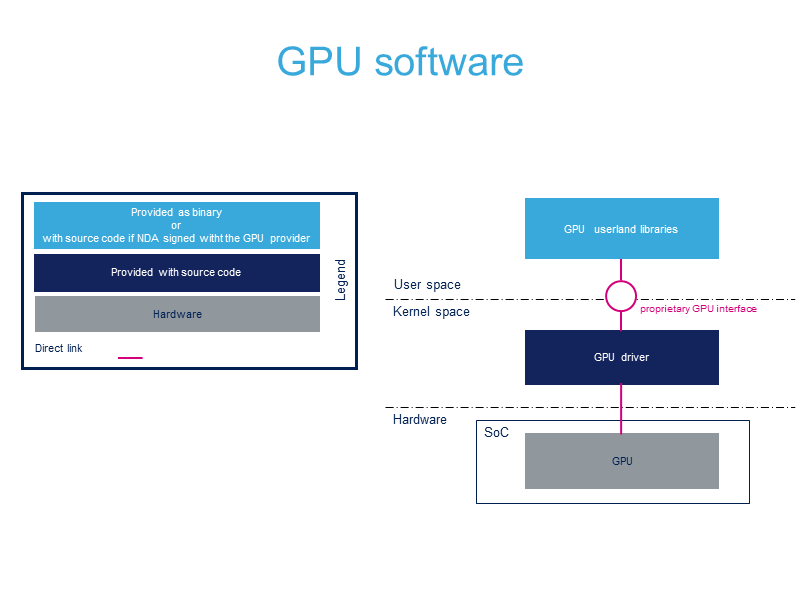“Vivante GCNANO GPU overview”的版本间的差异
来自百问网嵌入式Linux wiki
| (未显示同一用户的9个中间版本) | |||
| 第8行: | 第8行: | ||
==Introduction== | ==Introduction== | ||
| − | + | STMicroelectronics STM32MP1平台具有基于'''Vivante Gcnano GPU'''的'''OpenGLES'''硬件IP。.<br> | |
| − | + | 您可以在'''Vivante GCNANO网页'''上找到更多信息。<ref> http://www.vivantecorp.com/index.php/en/media-article/news/281-20140602-vivante-intros-worlds-first-complete-line-of-gpus-for-wearables-and-iot.html </ref> <ref> http://www.vivantecorp.com/index.php/en/technology/3d.html </ref> | |
==Features== | ==Features== | ||
===Supported open standards=== | ===Supported open standards=== | ||
| − | + | '''Vivante Gcnano GPU''' 与以下'''Khronos的开放标准3D图形'''<ref> http://www.khronos.org/ </ref>: | |
* OpenGLES 2.0 | * OpenGLES 2.0 | ||
* OpenGLES 1.1 | * OpenGLES 1.1 | ||
| 第34行: | 第34行: | ||
===Vivante Gcnano GPU userland libraries=== | ===Vivante Gcnano GPU userland libraries=== | ||
| − | + | 除非客户与Vivante签署了保密协议(如果需要这些库源代码,请联系Vivante)。 Gcnano库(用户)是: | |
* OpenGLES 1.1 library | * OpenGLES 1.1 library | ||
| 第45行: | 第45行: | ||
===Vivante Gcnano kernel driver=== | ===Vivante Gcnano kernel driver=== | ||
| − | '''{{Green|Source code is available for all customers}}''' | + | '''{{Green|Source code is available for all customers}}''' 在所有OpenSTLinux基准中。 <br> |
<br> | <br> | ||
| − | + | 要访问源代码,请执行以下操作: | |
| − | + | devtool修改gcnano-driver-stm32mp | |
| − | + | 然后在此处下载源代码: | |
*'''<your_view>/build*/workspace/sources/gcnano-driver-stm32mp''' | *'''<your_view>/build*/workspace/sources/gcnano-driver-stm32mp''' | ||
<br> | <br> | ||
| − | + | 请参阅 [[OpenEmbedded - devtool]] 以了解有关devtool的更多信息。 | |
===Additional information=== | ===Additional information=== | ||
| − | * | + | * 意法半导体(ST)根据任何基准版本提供'''调试Vivante Gcnano库''','''允许客户使用Vivante工具套件(VTK)'''对应用进行调试/分析。 请查看文章 [[How to debug the Gcnano GPU with VTK]]了解更多详细信息。 |
==Useful links== | ==Useful links== | ||
| − | * | + | * Vivante网站: http://www.vivantecorp.com/ |
==EGL== | ==EGL== | ||
===Supported EGL backend=== | ===Supported EGL backend=== | ||
| − | + | 从VIVANTE交付的VIVANTE_GAL3D_Unified_Src_drv_6.1.x开始,Vivante Gcnano库支持'''DRM / GBM'''和'''Wayland'''后端。<br> | |
| − | + | 有关详细信息,请参见[[EGL backends]] 文章。 | |
===EGL texture 0-copy=== | ===EGL texture 0-copy=== | ||
| − | + | Gcnano支持EGL纹理0副本扩展。 | |
| − | + | EGL纹理0副本扩展允许EGL应用程序避免通过将纹理从应用程序复制到GPU来与GPU共享纹理缓冲区。 | |
| − | + | 有关更多详细信息,请参见 [[EGL texture 0-copy]] 文章。 | |
==Graphic Benchmarks== | ==Graphic Benchmarks== | ||
| − | + | 请参考 [[How to test and benchmark OpenGLES]]文章。 | |
==Debugging== | ==Debugging== | ||
| − | + | 请看以下文章: | |
* [[How to activate the Gcnano GPU debug mode]] | * [[How to activate the Gcnano GPU debug mode]] | ||
* [[How to debug the Gcnano GPU with VTK]] | * [[How to debug the Gcnano GPU with VTK]] | ||
2020年11月10日 (二) 09:48的最新版本
目录
Introduction
STMicroelectronics STM32MP1平台具有基于Vivante Gcnano GPU的OpenGLES硬件IP。.
您可以在Vivante GCNANO网页上找到更多信息。[1][2]
Features
Supported open standards
Vivante Gcnano GPU 与以下Khronos的开放标准3D图形[3]:
- OpenGLES 2.0
- OpenGLES 1.1
- OpenVG 1.1
- EGL 1.4
Vivante Gcnano GPU configuration
- Core Clock 264MHz
- Shader Clock 264MHz
- Pixel Rate 264 MPixel/sec
- Triangle Rate 26.4 M tri/sec
- Vertex rate 66 M vtx/sec
- 1 shader core (Vec 4)
- 2.112 GFLOPS shader
GPU softwares

Vivante Gcnano GPU userland libraries
除非客户与Vivante签署了保密协议(如果需要这些库源代码,请联系Vivante)。 Gcnano库(用户)是:
- OpenGLES 1.1 library
- OpenGLES 2.0 library
- EGL 1.4 library
- gbm library
- GAL library
- GLSLC and VSC libraries
- VDK library
Vivante Gcnano kernel driver
Source code is available for all customers 在所有OpenSTLinux基准中。
要访问源代码,请执行以下操作:
devtool修改gcnano-driver-stm32mp
然后在此处下载源代码:
- <your_view>/build*/workspace/sources/gcnano-driver-stm32mp
请参阅 OpenEmbedded - devtool 以了解有关devtool的更多信息。
Additional information
- 意法半导体(ST)根据任何基准版本提供调试Vivante Gcnano库,允许客户使用Vivante工具套件(VTK)对应用进行调试/分析。 请查看文章 如何使用VTK调试Gcnano GPU了解更多详细信息。
Useful links
- Vivante网站: http://www.vivantecorp.com/
EGL
Supported EGL backend
从VIVANTE交付的VIVANTE_GAL3D_Unified_Src_drv_6.1.x开始,Vivante Gcnano库支持DRM / GBM和Wayland后端。
有关详细信息,请参见EGL backends 文章。
EGL texture 0-copy
Gcnano支持EGL纹理0副本扩展。
EGL纹理0副本扩展允许EGL应用程序避免通过将纹理从应用程序复制到GPU来与GPU共享纹理缓冲区。
有关更多详细信息,请参见 EGL texture 0-copy 文章。